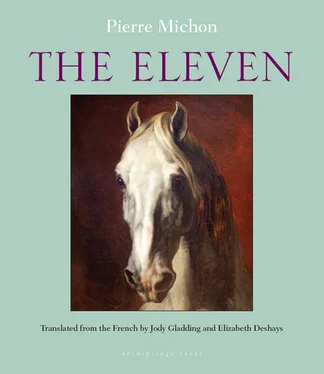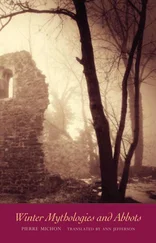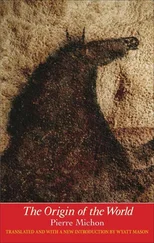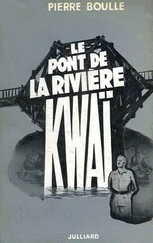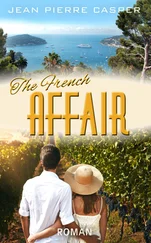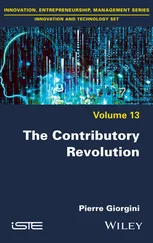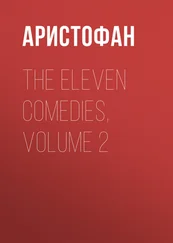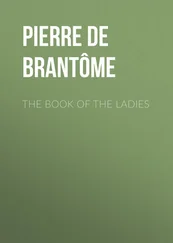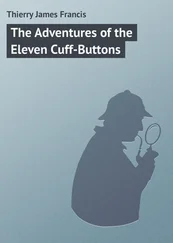It could not be otherwise.
Because, Sir, Géricault’s sketch is only valuable for having inspired Lord After-the-Fact himself, Michelet, Jules Michelet was his complete official name, to write the definitive twelve pages that discuss The Eleven , that assign The Eleven a place and set them before the historiographic tradition for centuries to come.
What really happened on that night when luck loosened its generous purse from its belt and produced the possibility of The Eleven , we do not know, Sir. Are we even sure it was night? All we know, knowledge or legend, are the theatrical effects, the coat the color of the smoke of hell rushing past, the self-assurance of four men in two-cornered hats, the empty nave and the horses in the nave, the lowered bells, the pile of gold and glowing bones of saints; three characters who are types, Collot in the role of Macbeth, Bourdon as Iago, Proli as Shylock; and before these stereotypes Corentin, struck dumb between the spilled gold and the phantom sound of bells, plays the role of Saint Matthew, who is not in Shakespeare. That is how we see it.
That is how it was arranged. Because, I repeat, Sir, all that originated — or rather was given definitive form, for Géricault had already hinted at it before Michelet — was formalized and dramatized in the hazy, hibernal mind of Michelet, under his impeccable hand, in the city of Nantes at the end of the Loire in the winter of 1852, in the Barbin quarter in the house called the Haute Forêt, the erstwhile Barbin quarter now called the Michelet quarter, where he wrote the pages on the Terror; when banished to Nantes by Napoléon III and broaching the subject he rightly considered to be the climax of History, he identified with both Carrier and Carrier’s rotten barges, with Providence and its old enemy Liberty, with the guillotine and the Resurrection of the flesh. When, like us, he entered with his subject into the night and into winter.
Michelet’s twelve pages on The Eleven in the third chapter of the sixteenth volume of the History of the French Revolution , those twelve pages extrapolated, that novel was taken at face value by the whole historiographical tradition: it comes up everywhere and is treated in various ways by all the schools that have commented upon, vilified, or celebrated the Terror. And, whether they vilify or celebrate it, all those historians, followed by the educated who read them, and then the uneducated who hear vague talk of them, and I myself, Sir, in my rambling, all of us, despite our various opinions that vary only slightly, all of us see at the physical origin of the great painting in the Louvre the night of Nivôse or Ventôse in Saint-Nicolas; from the corner of our eye, we all take in the gold and the bones; we are, of course, under the spell of the square lantern, the lantern of horn; we hear the horses; and, if we are romantic, we hear the bells as well. But it originated with Michelet. And as it comes to us from Michelet, it is the soul of Michelet that speaks in us: that thus seems to emerge from a painting by Caravaggio and not by Tiepolo.
Of those twelve pages, an entire page and a half are devoted to the commission: to the occasion, to the small extraordinary moment that the Greeks called the kairos — that is the moment, Sir, when luck unhooks from its belt the special little purse, the one that is no longer expected, that, moreover, is never expected. And in that page and a half Michelet tells how, in February 1846, he went to Saint-Nicolas, not to pray, given that the death of God was something understood once and for all, but to visit the sacristy where The Eleven was commissioned — he had seen Géricault’s painting once ten years earlier, during one of his little memorial tours through France. He went to see it, to verify it, and we in turn can see Michelet at nightfall, the pale, trembling, prematurely white-haired man with his greatcoat entering the sacristy that, as you see, we cannot escape. He saw it. He saw it, he writes in italics, although we do not know if that vision applies to the sacristy still enduring as a sacristy, or to the inspired place where The Eleven was decreed, that is, the brief headquarters of the Gravilliers section. He saw the chasubles on the little table upon entering where one evening in year II the coat the color of the smoke of hell coexisted with the bust of Marat; he saw the fire dying on the hearth; only the square lantern set there on the holy table was still flickering in the remains of daylight; reflections on small gold or copper objects; and perhaps even on the holy table the remains of a snack left by the sextons and guards. Above all he saw the armchair in which he says Proli had sat, the sulfur armchair, the yellow volcanic armchair in which, quietly, Couthon is sitting at the center of The Eleven . He saw the yellow armchair; he says that it is there that Corentin got the idea; I do not think I agree with Michelet: because I, too, Sir, have seen the yellow armchair, but it was not the same, not in the same place, because each real thing exists many times, as many times perhaps as there are individuals on this earth. I saw the armchair of The Eleven and it was not the same armchair as Michelet’s; I saw it in the Carnavalet museum where it is on display every day of the year, except Mondays and holidays because it is a public museum, the seat of impotence and glory — the chair of the paralytic Couthon, mounted on three wheels with a large wheel on either side and a small wheel behind, his wheelchair as we now say, his wheelbarrow as they said mockingly after Thermidor, the wheelchair that no longer has the slightest color, faded with time, or rather only the color of time, but which the little plaque at the Carnavalet museum describes as having once been yellow, because it is yellow in the painting of The Eleven .
Michelet saw those objects that were so many symbols in the sacristy in February, that den of the priests’ party into which he entered in his greatcoat under cover of darkness to verify The Eleven . And we will go along with him, despite all reservations regarding the yellow armchair; we will also go along with him when he speaks with terror of the nocturnal faces looming up, piercing, issuing from the night, and when he speaks tenderly of the oak table with the broken bread, the Clamart wine — the remains of the beadles’ afternoon snack. We might just possibly believe that he saw in 1846 the horses in the nave of 1793, the medieval relics thrown in the fire, the lowered, humiliated bells, his great bronze friend as he said, one of the only baubles of the priests’ party that he accepted because it rang not only to glorify God but also to announce uprisings, don Tocsinos as they said in 1793, that great friend who in February 1846 he heard plainly above his head sounding the hour of seven or eight in the evening: all that conforms to what we might think, might reconstruct of year II, and Michelet with greater reason than ours, who every day heard men of year II speaking of year II. It also conforms to what we know of Michelet. But when he transposes this scene of the commission, as is, onto the painting of The Eleven , then we can no longer go along with him.
For this confusion, this transposition, we can hazard a few hypotheses.
Perhaps Michelet had not revisited the great painting in the Louvre for a long time: we know that the painting frightened him, he remembered the excessive shock his first view of it had caused him, he avoided it because it possessed him, he praised it, detested it, idolized it, from a distance. Moreover in 1852 when he wrote of his vision and his visit to Saint-Nicolas in 1846, he was in Nantes at the end of the Loire, not on the banks of the Seine that bears The Eleven . So in the scene of the sacristy, lived in 1846, recounted in 1852, he redraws it from memory and falsifies it, in good faith perhaps or with the perversity of priest against priests, for which he is known. And in that falsification, that reconstruction from memory, in the famous twelve pages, he thus applies to the great painting what he saw, imagined, and cobbled together that day (in the sacristy and regarding the sacristy): he says that in The Eleven itself we see the great oak table and the horn lantern on the table; above all he says that we see the horses there, the horses in their stalls of sulfur, of gold, of basalt, their stalls à la nation , the horses of hell and the adoration. To be fair to Michelet, we can imagine that, among the prodigious and prodigiously cluttered bric-à-brac that served as memory for him, he had other paintings for guides and markers, Géricault’s Charging Chasseur , a battle by Rubens, the illustrations that Fuseli did for Macbeth , or the emblematic mare in The Nightmare by that same painter — or again, perhaps, that Michelet at his writing table, having just invented and articulated his own fable of a horse laughing in the night behind the partition, in the scene in which the three sorcerers commission the painting of The Eleven from the enchanter, Michelet is no longer the master of his fiction, that this perfect fable that just sprang from his mind intoxicates him, transports him, and he mounts it without a second thought. I myself do not see the square lantern there before us in the painting at the Louvre; I am afraid that it may come directly from Madrid, from Goya’s Tres de mayo , the Third of May, where it lights the scene of a slaughter, a mass murder, not from The Eleven — although something like a lantern does light The Eleven , but what? Nor do I see the holy table, although no doubt there must be something like a table to hold Prieur de la Marne’s hat at that level, since it cannot stay there by itself, cannot float at waist height by the sole virtue of the Holy Spirit. And above all I cannot see the horses. And you, Sir, can you see them?
Читать дальше
